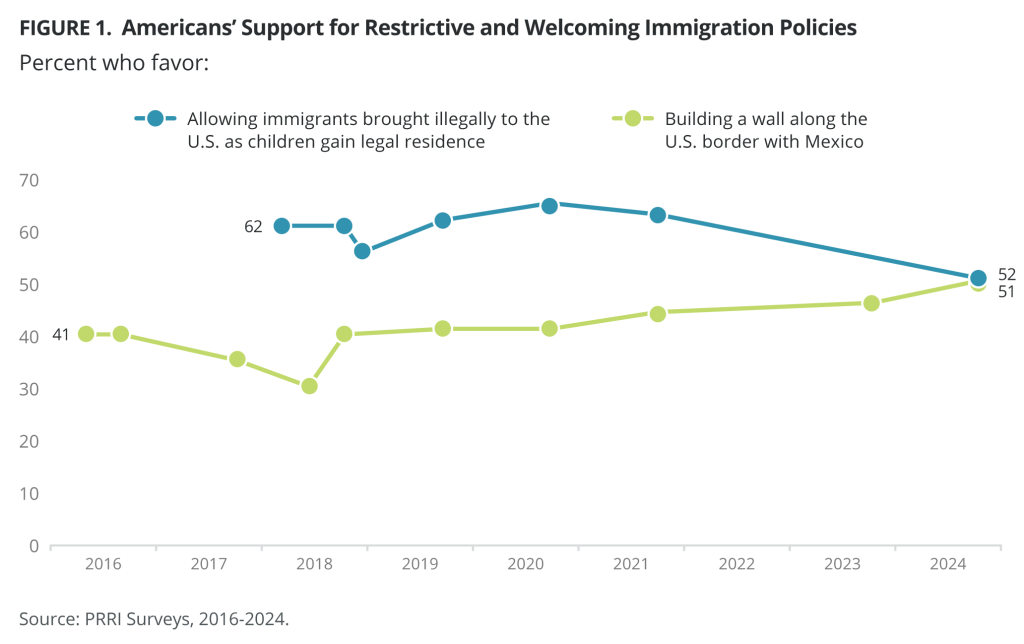Sergio M. González, Ph.D., is a 2024-2025 PRRI Public Fellow and an assistant professor of history at Marquette University in Milwaukee. He is a historian of twentieth-century U.S. migration, labor, and religion.
In his first week in office, President Donald Trump moved swiftly to enact campaign promises to restrict immigration and access to asylum, further militarize the U.S.-Mexico border, and implement the “largest mass deportation operation” in American history. Among the nearly five dozen executive orders he issued, 11 were focused extensively on immigration. One particular order aims to hold accountable municipalities that refuse to comply with the new administration’s immigration priorities. Entitled “Protecting the American People Against Invasion,” this executive order promises to withhold federal funds and bring criminal and civil lawsuits against cities, counties, and states interfering with federal immigration enforcement. In support of this order, the Department of Justice has also established a “Sanctuary Cities Enforcement Working Group” that will identify those municipalities that resist the president’s immigration agenda. This Spotlight Analysis examines how a second Trump administration is influencing sanctuary policies and shaping Americans’ shifting views on immigration policy.
Over the last decade, Trump has zeroed in on sanctuary cities as key targets in his efforts to both crack down on undocumented immigration as well as resistance to his political power. During his first week in office in 2017, he signed an executive order that sought to strip federal funding from those cities and states that refused to cooperate with immigration enforcement. While California counties successfully challenged the order in court, sanctuary cities remained a salient national issue throughout Trump’s first term: A growing number of Democratic mayors and city councils reaffirmed their commitment to sanctuary practices while conservative state legislatures and governors attempted to suppress these policies.
As was the case during his previous runs for office, Trump made hardline immigration policies, including attacks on sanctuary, a touchstone of his most recent presidential campaign. Polling conducted by PRRI in recent years shows a potential alignment between his priorities and growing support for stricter immigration enforcement among Americans. According to the PRRI 2024 American Values Survey, a majority of Americans now support building a wall (51%, up from 41% in 2016) along the U.S.-Mexico border, while nearly half of Americans (47%) support rounding up and deporting undocumented immigrants, “even if it takes setting up encampments guarded by the U.S. military.” And even executive actions like Deferred Action for Childhood Arrivals and other policies that would allow immigrants brought to the United States as children to gain legal resident status, which had received relatively high and consistent support over the last decade, have become less appealing to Americans; according to PRRI polling, only 52% of Americans now back these policies, the lowest rate since PRRI began tracking this data in 2018 (62%).
With polling demonstrating an increasing desire for more restrictionist immigration legislation, what appetite will Americans and elected officials have for sanctuary city guidelines during a second Trump administration? Mayors and city councils in places like Boston, Portland, Los Angeles, and Chicago have reaffirmed their support for defending undocumented residents, but others have become reticent about using the term “sanctuary” and have expressed a willingness to rethink cooperation with federal immigration enforcement.
The heavily politicized nature of the term sanctuary city has often been difficult to define. Born out of the 1980s sanctuary movement, which sought to provide refuge in houses of worship for Central American asylum seekers, sanctuary-city policies generally aim to protect undocumented immigrants by limiting cooperation between local law enforcement and federal immigration agencies. Hundreds of cities, counties, and states across the country that have adopted these procedures may direct their police officers and sheriffs to refrain from detaining individuals solely based on their immigration status and not allow local officers to hold undocumented individuals in detention longer than necessary for immigration agents. Supporters argue that these policies allow local law enforcement to focus resources on public safety priorities while promoting trust between officers and immigrant communities. Further, crime rates are generally lower in sanctuary counties, where undocumented individuals feel more encouraged to report crimes and cooperate with investigations without fear of deportation. Critics of sanctuary policies, however, contend that these practices undermine the rule of law and impede federal law enforcement’s efforts to deport undocumented individuals who have committed crimes.
Diverse responses from elected officials, including many who once voiced unwavering support for sanctuary city policies, may potentially be reflective of an increasingly complex and shifting landscape in U.S. immigration politics, mirroring broader divisions among Americans. When PRRI’s 2024 American Values Survey asked participants to what extent they agreed with the following statement — “Immigrants increase crime rates in local communities” — only a slight majority of respondents (54%) disagreed, a decrease from when they were asked a similar question earlier in the summer (59%).
If a growing number of Americans believe there is a positive correlation between immigrants and crime — a contention at the center of Trump’s immigration policies — city, county, and state elected officials, seeking to respond to their constituents, may be more willing to reconsider the very sanctuary policies that have provided protections for their undocumented residents for years.
